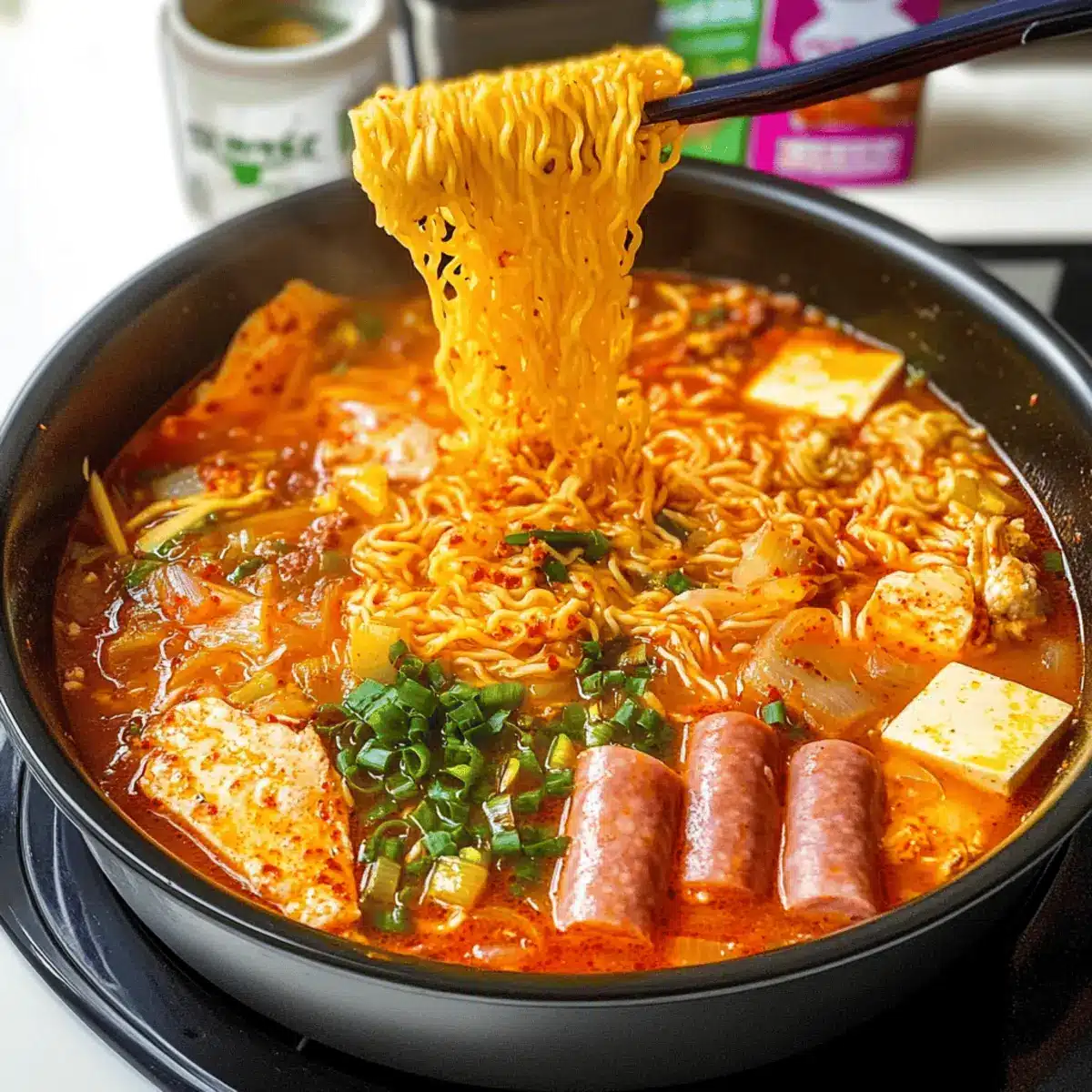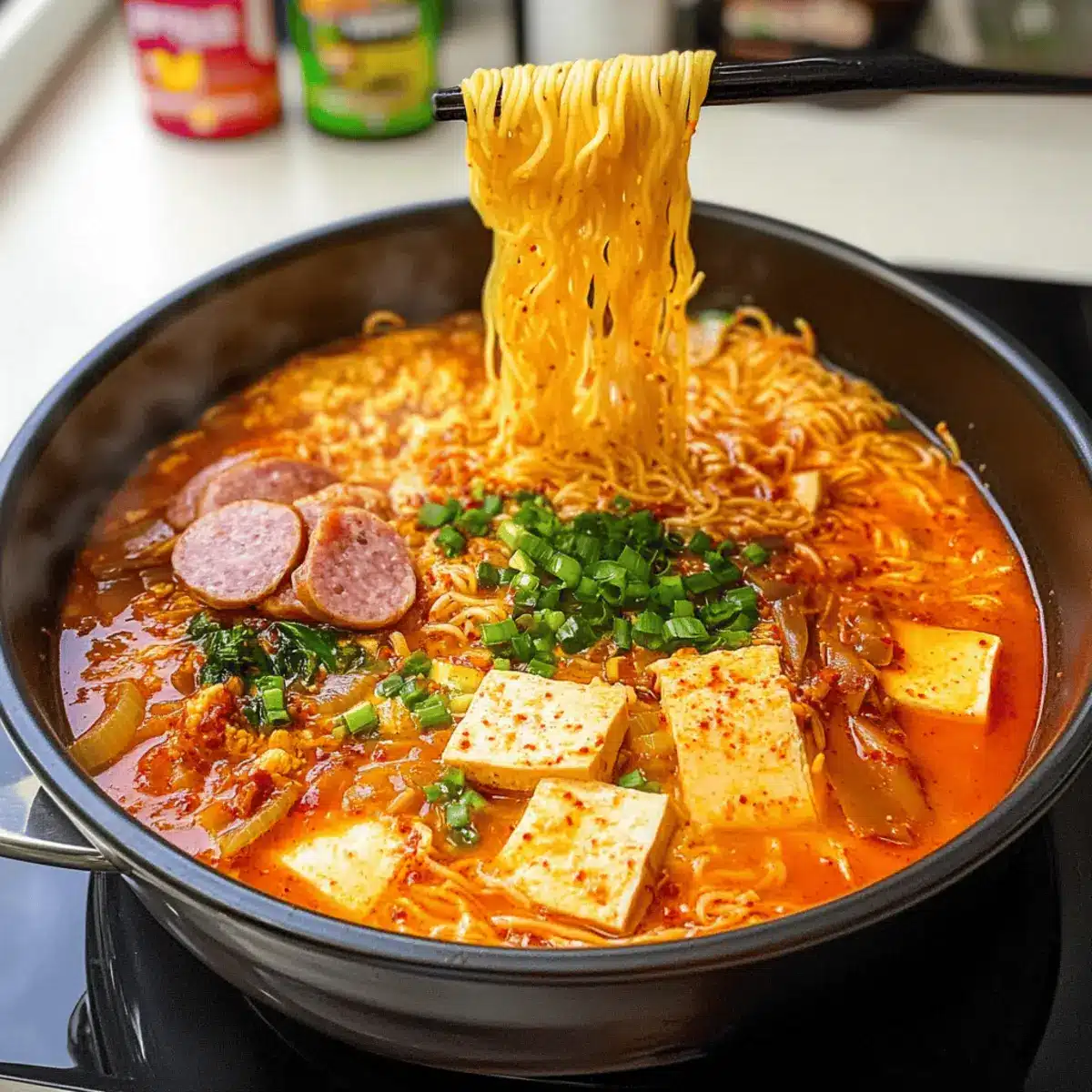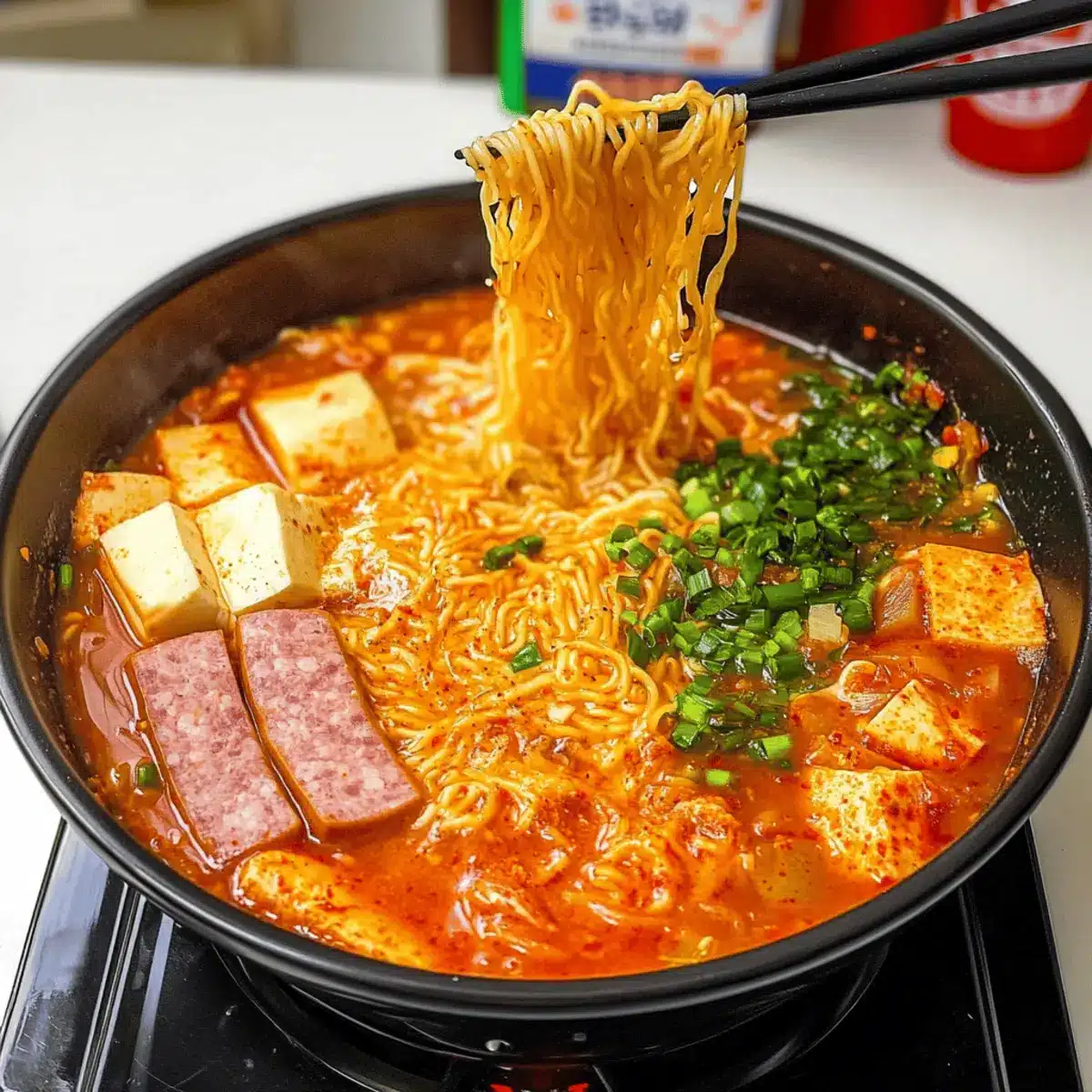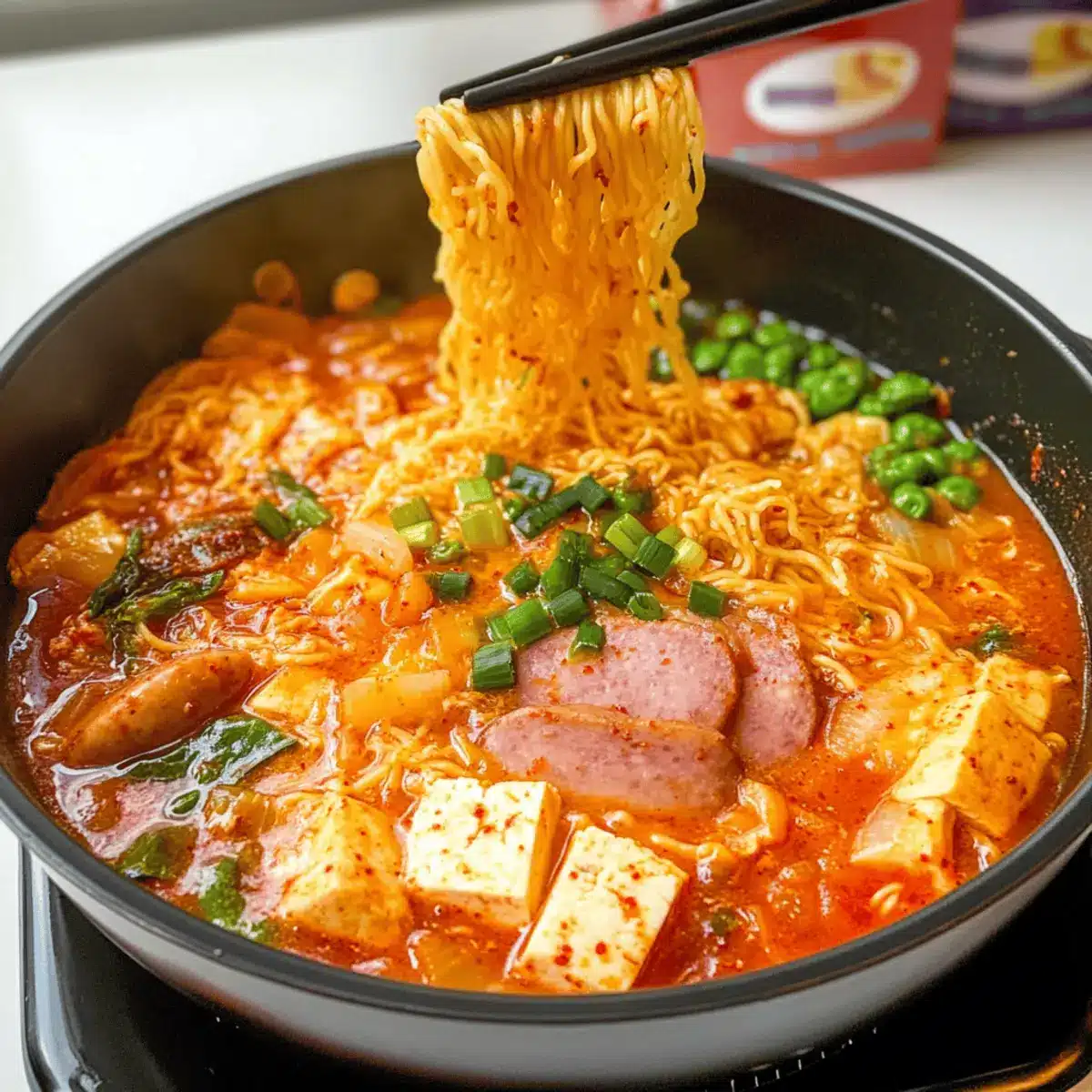As I stood in my kitchen, the tantalizing scent of bubbling Budae Jjigae danced in the air, a comforting reminder of my favorite Korean-inspired meals. This Hearty One-Pot Korean Army Stew effortlessly combines traditional flavors with a modern twist, making it the perfect dish for busy weeknights or cozy gatherings. Not only is Budae Jjigae simple to whip up, but its adaptable ingredients mean you can customize it to suit your taste—whether you prefer a hearty meat version or want to go plant-based! With each spoonful, you’ll enjoy the rich layers of flavor and texture, from tender noodles to savory protein, making this a dish that warms both the body and soul. Are you ready to dive into a bowl of this delicious stew and discover your own twist on this beloved classic?

Why is Budae Jjigae a Must-Try?
Comforting, Hearty Dish: Budae Jjigae is the epitome of comfort food, fusing rich flavors that will satisfy your soul.
One-Pot Simplicity: This recipe requires minimal cleanup since everything comes together in one pot, making weeknight cooking a breeze.
Customizable Ingredients: Embrace your inner chef by substituting proteins and veggies according to your preferences; the options are endless!
Quick to Prepare: You can have this delicious stew ready in about 30 minutes, perfect for those busy days.
Crowd-Pleasing Flavor: Whether hosting a dinner party or enjoying a cozy night in, this dish appeals to everyone—with its spicy, savory goodness, it’s sure to impress!
Serve with a Twist: Pair it with crusty bread or steamed rice to soak up the flavorful broth, and take your meal to another level!
Budae Jjigae Ingredients
-
For the Protein
-
Spam – Adds a salty, savory protein; for a lighter option, substitute with cooked chicken or tofu.
-
Sausages – Provides a hearty texture; any preferred cooked sausage such as kielbasa or hot dogs will work.
-
Tofu – Offers a soft texture that absorbs flavors; tempeh is a great alternative if you want a different taste.
-
For the Base
-
Rice Cakes – Adds chewiness and substance; you can replace them with noodles or increase the vegetable content.
-
Onion – A base flavor enhancing sweetness; yellow or white onions are ideal, while shallots can add a milder taste.
-
For the Veggies
-
Enoki Mushrooms – Contributes a delicate, crunchy texture; shiitake or button mushrooms can be used as substitutes.
-
Kimchi – Offers a spicy, tangy bite that defines the stew; fresh or store-bought kimchi will elevate the flavors significantly.
-
For the Broth
-
Chicken Broth – The flavorful base of the stew; vegetable broth is perfect for a vegetarian version.
-
For the Noodles
-
Ramen Noodles – A filling carbohydrate choice; any type of noodles will work well, ensuring durability in the broth.
-
For the Creaminess
-
Cheese – Provides creaminess that enhances flavor and texture; American or mozzarella cheese works splendidly; feel free to omit for a dairy-free dish.
With these ingredients, you’re set to create a delicious Budae Jjigae that warms the soul and pleases the palate!
Step‑by‑Step Instructions for Budae Jjigae
Step 1: Prepare the Sauce
In a mixing bowl, combine minced garlic, gochugaru, gochujang, soy sauce, mirin, sugar, and black pepper. Stir until a smooth sauce forms, which should take about 1–2 minutes. This sauce will infuse the Budae Jjigae with vibrant flavors, setting the foundation for the delicious stew.
Step 2: Assemble the Ingredients
In a deep, shallow pot, layer your ingredients starting with sliced Spam, sausage, tofu, rice cakes, and onion. Add enoki mushrooms and kimchi on top for a flavor explosion. As you arrange these ingredients, aim for an even distribution to ensure all elements of the Budae Jjigae meld together beautifully while cooking.
Step 3: Combine Sauce and Broth
Pour the prepared sauce over the layered ingredients in the pot, making sure everything is adequately coated. Next, gently pour in chicken broth until all the ingredients are submerged. The liquid should cover the solids about an inch. This combination will create a hearty base that simmers into rich, comforting flavors.
Step 4: Simmer the Stew
Cover the pot with a lid and bring the mixture to a boil over medium heat, which should take about 5-7 minutes. Once bubbling, reduce the heat to low and let it simmer. Keep an eye on it, as the stew should gently bubble, allowing the flavors to meld together for another 10–15 minutes.
Step 5: Add Noodles and Cheese
After the initial simmering time, uncover the pot and stir in the ramen noodles and cheese. Cover once again and cook for an additional 3-5 minutes until the noodles are tender and the cheese has melted into a creamy blend. This step will give your Budae Jjigae that comforting and indulgent texture everyone loves.
Step 6: Garnish and Serve
Finally, remove the pot from the heat and garnish your Budae Jjigae with chopped green onions for a fresh pop of flavor. Serve the stew hot and bubbling over a bowl of steamed rice or with crusty bread, allowing everyone to enjoy the warming experience of this delightful dish.

What to Serve with Budae Jjigae?
Warm up your dining experience with delightful options that complement this savory, soul-soothing stew.
- Steamed Rice: The perfect companion to soak up the rich broth; it balances the spice and enhances every bite.
- Crusty Bread: Ideal for dipping, its texture adds a satisfying crunch while complementing the stew’s softness.
- Korean Pickled Vegetables: Bright and tangy, they provide a refreshing contrast to the bold flavors of the stew.
- Roasted Vegetables: Their caramelized sweetness can elevate the meal while adding a nutritious boost to your plate.
Serve these delightful pairings to create a wholesome dining experience that showcases the heart-warming essence of Budae Jjigae!
Variations & Substitutions for Budae Jjigae
Customize your Budae Jjigae to your heart’s content, transforming flavors and textures into something uniquely delicious!
- Vegetable Boost: Add zucchini, carrots, or bok choy for a vibrant, nutritious twist. The stewing process will soften these veggies, enhancing their natural sweetness.
- Protein Variety: Swap out Spam for cooked chicken, shrimp, or beef to cater to different preferences. Each protein will bring its own richness to the stew, making it adaptable for various diets.
- Plant-Based Delight: Go completely vegan by using tempeh or extra tofu in place of meat. The tofu will soak up the flavorful broth, ensuring a satisfying bite every time.
- Mushroom Medley: Trade enoki mushrooms for shiitake or button mushrooms to change the texture and flavor profile. Each kind offers a delightful chewiness that complements the dish.
- Noodle Options: Feel free to replace ramen noodles with udon or soba noodles. Each noodle adds a unique bite, letting you enjoy a different culinary experience while maintaining the heartiness of the stew.
- Flavor Enhancements: Add a splash of soy sauce or a teaspoon of sesame oil for an extra umami punch. The richness will elevate the stew, making it even more mouthwatering.
- Cheese Swap: If you want to go dairy-free, simply omit the cheese or use a plant-based cheese alternative. This will still maintain creaminess while catering to dietary restrictions.
If you’re feeling adventurous, you might even throw in some leftover veggies or proteins you have at home to reduce waste and add even more flavor. Check out our guide on Creative Leftover Recipes for more inspiration!
Expert Tips for Budae Jjigae
- Optimal Simmering: Allow the stew to simmer longer for deeper flavors; patience is key to a rich, comforting Budae Jjigae.
- Fresh Ingredients: Always use fresh kimchi and vegetables for superior flavor; they can make a significant difference in the final dish.
- Spice Control: If you’re sensitive to heat, start with less gochugaru and gochujang, adjusting gradually to reach your personal spice level comfortably.
- Ingredient Evenness: Layer ingredients evenly in the pot to ensure each bite is infused with balanced flavors, enhancing your overall Budae Jjigae experience.
- Leftover Love: Don’t hesitate to add leftover veggies or proteins; they can elevate your stew creatively while reducing waste.
Make Ahead Options
Budae Jjigae is a fantastic recipe for meal prep enthusiasts looking to save time on busy weeknights! You can prepare the base of your stew—layering the Spam, sausages, tofu, rice cakes, onion, enoki mushrooms, and kimchi—up to 24 hours in advance, covering it tightly before refrigerating. This helps the flavors deepen while maintaining ingredient quality. Additionally, you can whisk together the sauce ingredients and store them in an airtight container for up to 3 days. When you’re ready to enjoy your hearty Budae Jjigae, simply pour the sauce and chicken broth over your prepped ingredients, bring to a boil, and add the noodles and cheese for that perfect finish, ensuring a comforting meal with minimal effort!
Storage Tips for Budae Jjigae
- Fridge: Leftovers can be stored in an airtight container for up to 3 days. Ensure that the stew cools to room temperature before sealing to maintain freshness.
- Freezer: If you have more than you can eat, freeze Budae Jjigae in portions for up to 2 months. Use freezer-safe bags or containers to prevent freezer burn.
- Reheating: When ready to enjoy your stew again, thaw overnight in the fridge if frozen, then reheat on the stovetop over low heat until warmed through. Add a splash of broth or water if it’s too thick.
- Taste Maintenance: Keep in mind that the texture may slightly change, especially with noodles; biting into soft noodles after freezing might be different, but the flavors will still be comforting!

Budae Jjigae Recipe FAQs
How do I choose the right kimchi for Budae Jjigae?
Absolutely! Fresh kimchi is ideal as it adds a vibrant, tangy flavor. Look for kimchi that isn’t overly fermented, as you’ll want some crunch and spice. If you’re using store-bought, aim for brands that highlight freshness on the label or check for the crunchiness by giving it a little squeeze before purchasing!
How long can I store Budae Jjigae in the fridge?
Very! Leftovers can be stored in an airtight container for up to 3 days. Let the stew cool to room temperature before sealing it to maintain freshness. When you’re ready to enjoy, simply reheat it on the stovetop over low heat for the best results.
Can I freeze Budae Jjigae?
Absolutely! You can freeze Budae Jjigae in portions for up to 2 months. To do this, let the stew cool completely, then transfer it into freezer-safe bags or containers, removing as much air as possible. When you’re ready to enjoy it, thaw overnight in the fridge, then reheat gently on the stovetop. If it seems too thick, add a splash of broth or water as you warm it up.
What should I do if I find my Budae Jjigae too spicy?
If the spice level is too intense, you can balance it by adding more chicken broth or coconut milk to dilute the heat. You can also toss in additional vegetables like diced potatoes or carrots during the simmering stage; they’ll absorb some spice while adding delicious layers to your stew. If you prefer milder flavors, you might want to start with less gochugaru and gochujang in the initial sauce preparation.
Can pets eat Budae Jjigae leftovers?
Not really! It’s best to avoid giving Budae Jjigae to pets as it contains ingredients like spicy kimchi, garlic, and onions that can be harmful to them. If you have leftover plain meat or tofu, however, without any spice or seasonings, these can be enjoyed by your furry friends in moderation. Always check with your vet if unsure about specific ingredients!
Is it possible to make Budae Jjigae vegetarian?
Very much so! You can create a delicious vegetarian version by swapping Spam and sausages for tofu or tempeh, and using vegetable broth instead of chicken broth. Additionally, pack in a variety of vegetables, like zucchini or bok choy, to enhance the stew’s texture and flavor. Enjoy experimenting with different combinations to suit your dietary preferences!

Budae Jjigae: A Soul-Warming Korean Army Stew Recipe
Ingredients
Equipment
Method
- In a mixing bowl, combine minced garlic, gochugaru, gochujang, soy sauce, mirin, sugar, and black pepper. Stir until a smooth sauce forms, about 1-2 minutes.
- In a deep, shallow pot, layer your ingredients starting with sliced Spam, sausage, tofu, rice cakes, and onion. Add enoki mushrooms and kimchi.
- Pour the prepared sauce over the layered ingredients. Then, gently pour in chicken broth until all ingredients are submerged.
- Cover the pot with a lid and bring to a boil over medium heat for about 5-7 minutes. Once bubbling, reduce heat to low and let it simmer for another 10-15 minutes.
- After simmering, uncover the pot and stir in the ramen noodles and cheese. Cover and cook for an additional 3-5 minutes.
- Remove from heat and garnish with chopped green onions. Serve hot over a bowl of steamed rice or with crusty bread.

Leave a Reply